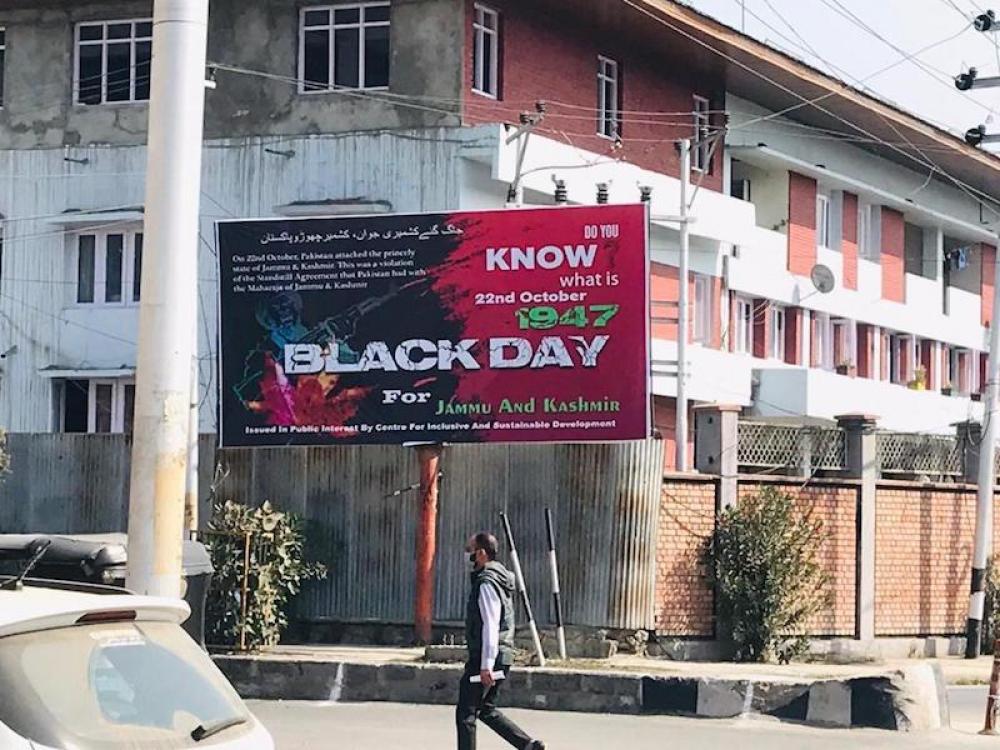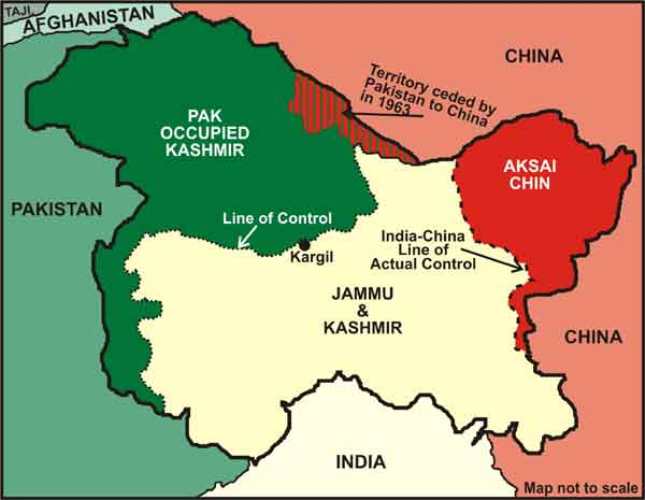Just Earth News | @justearthnews | 22 Oct 2020, 07:47 am Print
 Kashmir Black Day
Kashmir Black Day Srinagar: In a watershed moment for India's Jammu and Kashmir, locals in summer capital Srinagar have put up hoardings to commemorate October 22 as a Black Day when Pakistan had invaded the region in 1947 unleashing killings, rapes and plundering.
This counts as a significant step as it aims to renounce the action of a nation that has witnessed a surge in popularity in the recent past.
Indian-administered Kashmir's fondness for Pakistan and its people had often embarrassed India at the international level. However, the new development will ease a bit of that tension for Prime Minister Narendra Modi and his government.
The hoardings to remember Oct 22 as a Black Day are everywhere in Srinagar. A drive around the summer capital will catch anyone's eyes of them popping up as grim reminders of Kashmir endured in 1947.
A few days shy of the formation of Pakistan and the independence of India from the British rule, Maharaja Hari Singh, the Hindu Dogra ruler of Muslim-majority J&K at the time of Independence, seemed not too keen to join either dominion.

On 12 August 1947, he therefore sought a standstill agreement with both India and the then proposed land of Pakistan. He communicated to both that the “Jammu and Kashmir government would welcome standstill agreement with Union of India/Pakistan on all matters on which there exists arrangements with the outgoing British India government”.
However, as usual (and has been the case since), Pakistan dishonoured the agreement just 12 days after signing it.
On August 24, 1947 the Muslim majority nation threatened Maharaja Hari Singh by writing to him that “The time has come for Maharaja of Kashmir that he must take his choice and choose Pakistan. Should Kashmir fail to join Pakistan, the gravest possible trouble will inevitably ensue”.
Once Pakistan was sure that the Jammu and Kashmir region would likely be a part of India, it decided to use force.
"Intelligence reports from the frontier areas of Poonch and Mirpur as well as the Sialkot sector started coming in which spoke of large scale massacre, loot and rape of our villagers by aggressive hordes from across the borders. I recall the grim atmosphere that began to engulf us as it gradually became clear that we were losing control of the outer areas," a passage from Dr. Karan Singh- the son of Maharaja Hari Singh- reads.
Amsterdam-based European Foundation for South Asian Studies (EFSAS) report reads: "In early October, the Maharaja again protested to the Pakistani Foreign Ministry about the infiltration by tribals hundreds of kilometers inside the J&K border in the Jammu region."
22 October 1947. The Blackest day in the history of Jammu & Kashmir.
— Junaid Qureshi (@JQ_plaintalk) October 21, 2020
When the Islamic Republic of Pakistan violated the sovereignty of J&K, breached the signed Standstill Agreement with J&K, invaded J&K, killed, raped and looted us in an attempt to illegaly annex our homeland.
"Pakistan denied the allegation, but was all the while planning and preparing for Operation Gulmarg, its first armed attempt and one that relied heavily on external mercenaries, to seize J&K. It has in the 73 years since then used the same template to destroy J&K multiple times over.
"Operation Gulmarg had been conceived and put into action as early as on 20 August 1947, just six days after Pakistan was carved out from British India.
"The plan, as openly reported since, was for Pathan (Pashtun) tribes of Pakistan’s North-West Frontier Province (NWFP) to enlist at least one Lashkar (militant group) of 1000 tribesmen each. Political and strategic analyst Shuja Nawaz, who is a Distinguished Fellow of the South Asia Center at the Atlantic Council in Washington DC, has listed 22 Pashtun tribes that were involved in the invasion of Kashmir on 22 October 1947.
"Separate instructions for their recruitment were issued to the Deputy Commissioners and Political Agents of NWFP. After enlistment, these Lashkars were to be concentrated at Bannu, Wana, Peshawar, Kohat, Thal and Nowshera by the first week of September 1947. The Pakistan Army Brigade Commanders at these places were to issue them arms and ammunition.
.jpg)
"The Pakistani Army superimposed a Pathan Major, a Captain and ten JCOs of the regular Pakistan Army above each such armed Lashkar, and these Army regulars were required to dress and live exactly like the other Pathans in the Lashkar.
"The entire force was commanded by Major General Akbar Khan, code named General Tariq, who was assisted by Brigadier Sher Khan.
"Among those who planned, led, and financed Operation Gulmarg, the most prominent was Sardar Shaukat Hayat Khan, a close confidant of Pakistan’s founder Muhammad Ali Jinnah and a top leader of the Muslim League," the report added.
Apart from these, three books have highlighted how Pakistan managed to plan and carry out the assault and later spin it as a spontaneous attack, despite having a direct hand in it.
In his book 'Raiders in Kashmir', Late Maj. General Akbar Khan of Pakistan Army, who was involved in the Rawalpindi Conspiracy Case, showed how Pakistan planned the invasion and was directly involved in it.
Khan was then Director, Weapons and Equipment at GHQ. He devised a plan to use a previous government sanction for the issue of 4,000 military rifles to the Punjab Police and have the rifles transferred from the police to the raiders, a report by ANI said.
Likewise, old ammunition was secretly diverted for use in Kashmir. He even devised a plan titled 'Armed Revolt inside Kashmir' to strengthen Kashmiris internally and at the same time taking steps to prevent the arrival of armed civilians or military assistance from India into Kashmir, either by road or air.
Author Mohammad Saeed Asad's book titled 'Yaadon ke Zakhm' (Wounded Memories) has managed to collect a series of first-hand accounts that graphically reveal the brutalities inflicted by the raiders on the people.
Humayun Mirza wrote in his book 'From Plassey to Pakistan' that his father Iskander Mirza (later Governor-General of Pakistan) was tasked by Jinnah to raise a tribal Lashkar in February 1947 to wage a jihad against the British if they did not concede Pakistan, reported ANI.
EFSAS said it is time the Kashmiri people realise who their real enemies are.
"The planners and perpetuators of the tribal invasion were, and remain, without doubt the foremost enemies of the Kashmiri people. The day the invasion began on 22 October 1947, similarly, has to be the darkest day in the history of J&K," it said.
"It is about time that the people of J&K realized that the real tragedy is that Pakistan even today believes in the same policy and adopts the same methods that it did in 1947, no matter how acutely detrimental those may be to the interests and the well-being of the people of J&K," the report added.
- USD 5,000 fine for illegal entry: US unveils toughest immigration penalty yet
- Bangladesh: Former PM Khaleda Zia’s emergency medical evacuation to London delayed. Know the reason
- Mystery killing in Gaza: Key anti-Hamas leader Yasser Abu Shabab dead
- Washington DC shooting fallout: USCIS indefinitely halts Afghan immigration pending security and vetting review
- Trump accepts Xi’s invitation for Beijing visit during telephone interaction: Talks cover trade, Ukraine, and Fentanyl



-1763561110.jpg)


